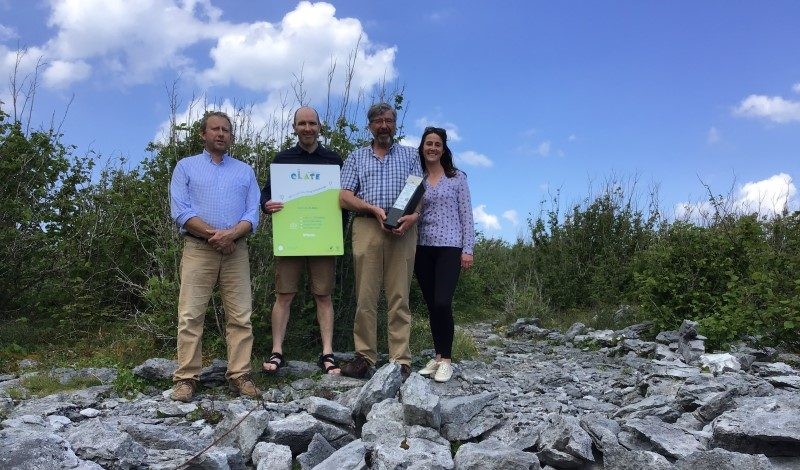Linking the physical and digital worlds via interactive signage – Ballyvaughan, Co. Clare
 Selected as an exemplar case study by DCU in partnership with .IE
Selected as an exemplar case study by DCU in partnership with .IE
Funded by .IE
Funding awarded: €5,000
Maturity: Pilot
Eoin Hogan
ehogan@CLDC.IE

Who:
Ballyvaughan Community Development Committee and Clare Local Development Company. Eoin Hogan led the project and also worked with local walking clubs, the Outdoor and Education Centre in Bell Harbour and local businesses.
Ballyvaughan is a small harbour village in Co. Clare on the west Atlantic coast of Ireland with a population of approx. 250. The main economic activity in the village is tourism. The town is a Fáilte Ireland “Walkers Welcome” village and connected to three official walking trails and the Eurovelo cycling route. These trails and cycle route attract a large quantity of both domestic and foreign tourists. Like many small towns and villages, it faces challenges in attracting visitors with its limited financial resources and marketing capacity when compared to other larger towns in the region. This technology can provide valuable assistance and insights to new visitors to an area and help towns promote businesses and steer visitors to specific destinations.
Objectives:
- To promote outdoor recreational activities in Ballyvaughan as an economic driver and promote the village as a tourism destination.
- To use digital means to appeal to a younger, more technically literate demographic than currently targeted.
- To develop a network of interactive digital walking and cycling recreational signs.
- To provide tourists and the local authority with insights on trail conditions and traffic.
What:
The Ballyvaughan Interactive Signage project is the development of an interactive outdoor recreation tourism infrastructure that links physical walking and cycling trails with the digital world. The interactive signs that have been installed along different trails provide details of hill’s length and gradient so that walkers and cyclists know what to expect. A Near Field Communication (NFC) Chip allows cyclists to tap the sign with their mobile phone and automatically open the Strava segment to view the fastest times for cycling the hill trails. Interactive signage and digital photo posts allow trail users to take and submit selfies and upload them to a dedicated trail’s website by touching a trail post. IoT flood sensors warn users of flooded sections of trails and people counters to monitor trail usage for the management committee.
Why:
Digital signage can help to create more intelligent, meaningful and sustainable connections between tourists and the destinations. There are a number of motivations to using this technology. First, it is a low-cost way to connect the digital world (Strava) and the physical world (popular cycling hill climbs) in order to improve the user experience. Secondly, enabling users to promote the walking and cycling trails through easily uploading their digital photos to the trails website or their routes through apps such as Strava may attract a new audience to the locality. Finally, the data provided by the systems can provide data on trail conditions which could ultimately improve the safety of the routes.
Scale:
Currently two digital signs are in place at Corkscrew and Ballalbin Hill and a number of digital photo posts along trails in Ballyvaughan.
Technologies:
The interactive signage for users includes Near Field Communication (NFC) Chips, QR code and tinyURL. IoT flood sensors, and people counters provide data for the management committee on conditions and usage.
NFC chips were installed in the walking trail marker posts, and stainless-steel smartphone holders attached to the top of the post. The website was upgraded to link to the NFC chip and the webpage backend included a feature where photos could be approved before going live on the site.
The interactive signage for users includes Near Field Communication (NFC) Chips, QR code and tinyURL. IoT flood sensors, and people counters provide data for the management committee on conditions and usage.
NFC chips were installed in the walking trail marker posts, and stainless-steel smartphone holders attached to the top of the post. The website was upgraded to link to the NFC chip and the webpage backend included a feature where photos could be approved before going live on the site.

Written by Dr. Jennifer Kennedy, The Irish Institute of Digital Business, Dublin City University.